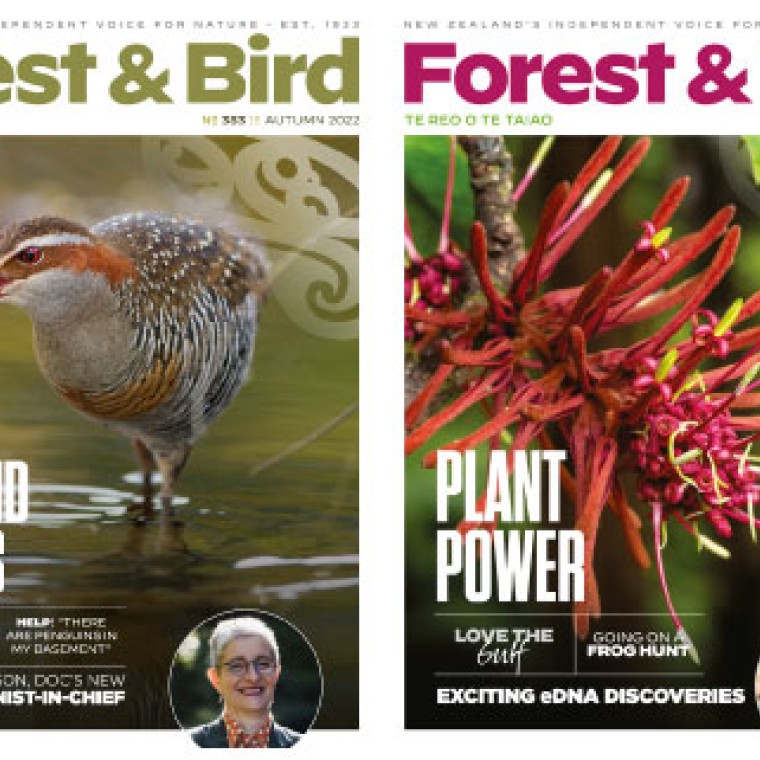Meet the Forest & Bird staff, volunteers, and communities working to restore wildlife on the Whangaparāoa Peninsula. By Jenny Hanwell
Forest & Bird magazine
A version of this story was first published in the Summer 2024 issue of Forest & Bird magazine.
One of Forest & Bird’s seven priority national projects, Pest Free Hibiscus Coast, is located in a diverse and nature-rich part of the Auckland region, in an area that’s as popular with people as it is with wildlife.
The project on the Whangaparāoa Peninsula, about 40km north of Auckland, covers a huge 3100ha, stretching from the Ōrewa estaury in the west to the border of Shakespear Open Sanctuary in the east and bordering Tīkapa Moana, the Hauraki Gulf. The peninsula is home to about 34,000 residents.
Just across the waters lies the famous bird sanctuary of Tiritiri Matangi Island, and Rangitoto and Motutapu aren’t much further away. This means the biodiversity of the area is significant, despite its large suburban population.
Peninsulas make ideal sites for predator control, and Forest & Bird’s vision for Pest Free Hibiscus Coast is to create a safe haven for native species transitioning from the surrounding nature sanctuaries in a way that engages and enthuses the community.
The project is now in its 11th year, having originated as a Hibiscus Coast Branch initiative founded by Pauline Smith in 2013. We continue to work closely with the branch as the capacity and impact of the project grows. I started as project manager in 2019 and now have a team of five staff and more than 175 volunteers.
Together, we operate a network of 2700 traps and bait stations in local parks and large private blocks, targeting rats, stoats, weasels, possums, and hedgehogs. Our conservation volunteers are a vital part of the project (see overleaf), contributing their time towards servicing traps, carrying out biannual pest animal monitoring and bird surveys, and helping with community events.
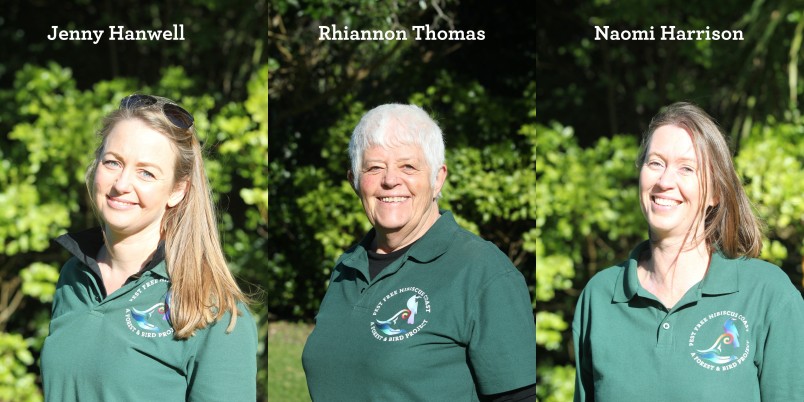
Rhiannon Thomas is Pest Free Hibiscus Coast’s volunteer coordinator, and her job over the past five years has been to keep volunteers engaged. She focuses on developing good working relationships with each volunteer, creating a sense of camaraderie through regular social events, and ensuring each individual volunteer finds a role they enjoy.
With her support, our volunteers have carried out 30,000 trap and bait station services in the last year alone, a huge contribution to nature protection at Whangaparāoa. Each year, we celebrate our volunteers with a summer BBQ and awards event, with gifts provided by our wonderful business sponsors.
Data management is essential for a project like ours, so we can be accountable, effective, and measurable. Field operations lead Naomi Harrison has been working with volunteers from New Zealand GIS In Conservation to create an easy-to-use volunteer data entry system so we can track our trapping network and progress towards our conservation goals.
Under Naomi’s leadership, our predator control network has grown hugely, and earlier this year we appointed Luke Wafer as our Field Support Officer. Luke assists with the installation of new trap lines and coordinates our network of Goodnature A24 traps. He also audits traps and monitoring lines to ensure everything is running smoothly.
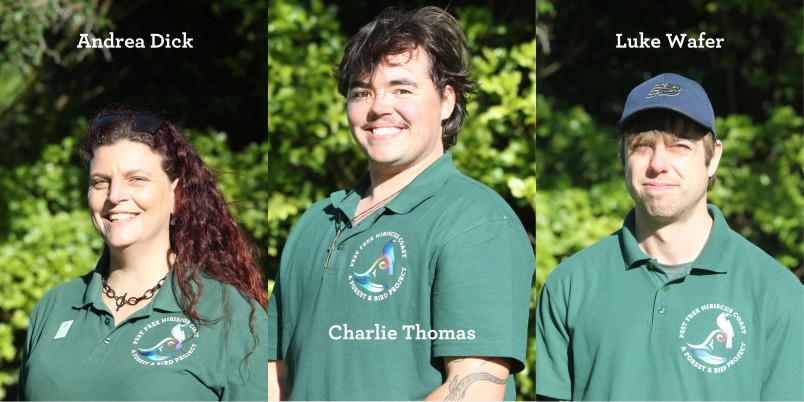
Pest Free Hibiscus Coast’s community engagement programme has taken off in recent years, thanks to the enthusiasm of community activator Andrea Dick. A vital part of the project is enabling local residents to take action in their own backyards, and increasing local awareness of the project and its goals has been essential for this.
Andrea has connected with “Coasties” from all walks of life through community events and school galas. She organised for local children to dress as native birds and cheeky rats at last year’s Ōrewa Santa Parade, which attracted 10,000 people, scooping the “most creative float” award.
We have recently increased the project’s community engagement capacity by adding Charlie Thomas to the team. Charlie was a founder member of Forest & Bird Youth in 2016 and has been passionate about conservation all his life. Charlie leads our social media programme and has been running a series of events to connect people with nature, including a hugely popular wetland walk in partnership with our Hibiscus Coast Branch.

Volunteer Jim Bettridge and project manager Jenny Hanwell. Credit Naomi Harrison
The project has recently established a reptile monitoring project, bringing in expertise from nationally recognised herpetologist Dylan van Winkel to create and oversee a monitoring programme for native skinks and geckos.
This has engaged several new volunteers, and new site records of threatened native lizards, such as ornate skink and forest gecko, are being added with each new survey round.
Pest Free Hibiscus Coast was highly commended in the Auckland Mayoral Conservation Awards 2022 for working with others across the community, and this mahi is central to our kaupapa.
We currently partner with Auckland Council to carry out predator control in more than 120 parks in the project area, working with local landowners, conservation groups, youth organisations, the Men’s Shed, and local businesses too.
This will never change because, for us here at Forest & Bird, conservation is about the whole community, not just a keen few.

Map of the Pest-free Hibiscus Coast project area. Credit Forest & Bird
WORKING WITH MANA WHENUA

Kaitiaki Ayla Walker with Jenny Hanwell. Credit Forest & Bird
Over the last year, Pest Free Hibiscus Coast has established a partnership with Ngāti Manuhiri to learn and better understand how we can combine western predator control practices with mātauranga Māori.
Together, we visited important conservation areas on the Hibiscus Coast and shared stories and insights about taonga species and how they can be better understood and protected.
This led to kaitiaki Ayla Walker creating a cultural framework for the project team so we can incorporate appropriate tīkanga into our operations.
We are working to implement these recommendations. Ngāti Manuhiri kaumātua gifted a karakia to the project, which we were honoured to receive.

Forest gecko (Mokopirirakau granulatus). Credit Dylan van Winkel
VOLUNTEER MAGIC
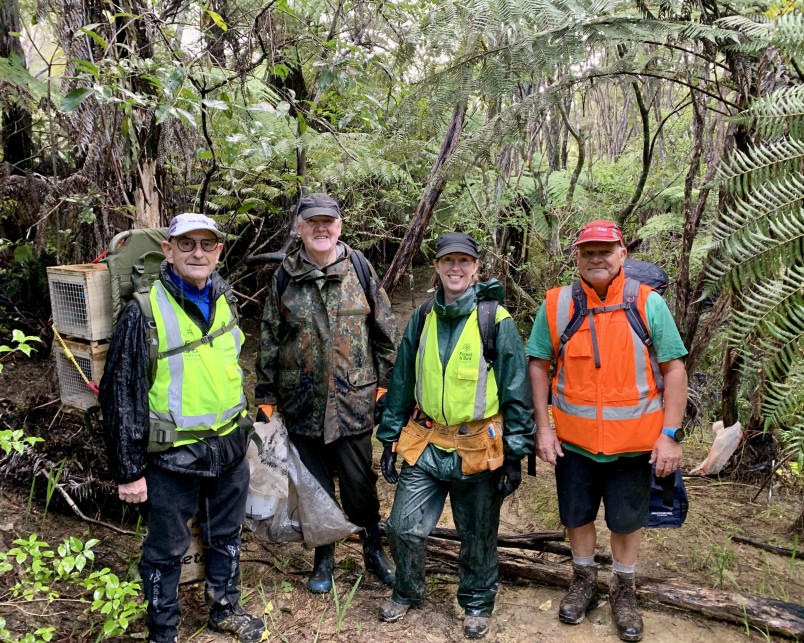
Pest Free Hibiscus Coast volunteers (from left) Gordon Whitelaw, Kelvin Hempseed, and Alan Wilkinson with Forest & Bird’s field operations lead Naomi Harrison. Credit Jenny Hanwell
The success of any community-based conservation project, including Forest & Bird’s Pest Free Hibiscus Coast, stems from the enthusiasm and dedication of its volunteers.
Ōrewa residents Gordon Whitelaw and John Paladin wanted to contribute towards conservation during their retirement on the Whangaparāoa Peninsula. In 2022, they were paired up by Pest Free Hibiscus Coast volunteer coordinator Rhiannon Thomas, who was looking for people to service a challenging trap line in Alice Eaves Bush.
Before long, they became firm friends and managed to catch possums, rats, and even a stoat in their first week. They service their trap lines weekly, get involved with bird and reptile surveys, and don their project t-shirts for community meet-ups.

John Paladin and Gordon Whitelaw. Credit Jenny Hanwell
John enjoys the social aspect of volunteering, as well as being out in nature helping control pests in his own backyard.
“Seeing an increase of bird life, getting feedback from friends, neighbours, and people in the street, as well as meeting Gordon, has made the experience worthwhile,” he said. “I enjoy the exercise and have learned more about the bush in the last two years than ever before.”
Gordon agrees: “Having been involved in bush and mountain running for 20 years, what I enjoy most about volunteering is that it enables me to maintain contact with nature, while also building new friendships.
“The good-humoured support of the staff and other volunteers is a bonus! I highly recommend volunteering with Forest & Bird.”
Next year, Forest & Bird plans to lead a series of events and activities to give residents increased opportunities to learn about, and connect with, nature on their doorstep, as well as continuing our important outreach work with schools.
Involving the community with ecological outcome monitoring is another key priority for 2025.
Last year, as the project marked its 10th birthday, Forest & Bird asked Elizabeth “Biz” Bell, of Wildlife Management International, to carry out an independent expert review of the Pest Free Hibiscus and make recommendations for its future direction.
Biz and her team met with volunteers, the community, and stakeholders, and reviewed all data and methodology. Her recommendations were detailed and centred around the fact that this is an important and strategic location for Forest & Bird’s conservation mahi.
The project has a comprehensive network of pest monitoring devices, including tracking tunnels and trail cameras. For the last two years, these have consistently shown possum density to be very low, down to 1% detection, with most catches occurring on new sites at the project boundaries.
Rats and hedgehogs are also decreasing, and close analysis of monitoring results enables the team to act quickly where there is evidence of higher densities. In the long term, the project will aim to eliminate introduced mammalian predators, starting with possums, as this has been assessed as technically feasible with the right budget.

Outreach with Ōrewa College students. Credit Matt Harrison
We have now collected 11 years of five-minute bird count data, with around 500 counts being done by volunteers each November. A Massey University analysis showed that 18 species were stable or increasing, with the tūī and riroriro grey warbler showing significant gains.
We are also tracking the appearance of less common species outside Shakespear Open Sanctuary. This year, there have been several records of kākāriki and pāteke, as well as kākā becoming regular visitors. We encourage our community to contact us with these sightings and record them on iNaturalist.
Forest & Bird is committed to helping native species continue to thrive on the Hibiscus Coast, although we recognise the currently challenging funding environment. We are grateful for grants from Auckland Council, Hibiscus & Bays Local Board, BlueSky Community Trust, and Foundation North over the past year.
The Society needs grants and donations to enable the project to continue in the coming years. If you would like to make a donation to Pest Free Hibiscus Coast, or would like to volunteer, please contact project manager Jenny Hanwell at j.hanwell@ forestandbird.org.nz.
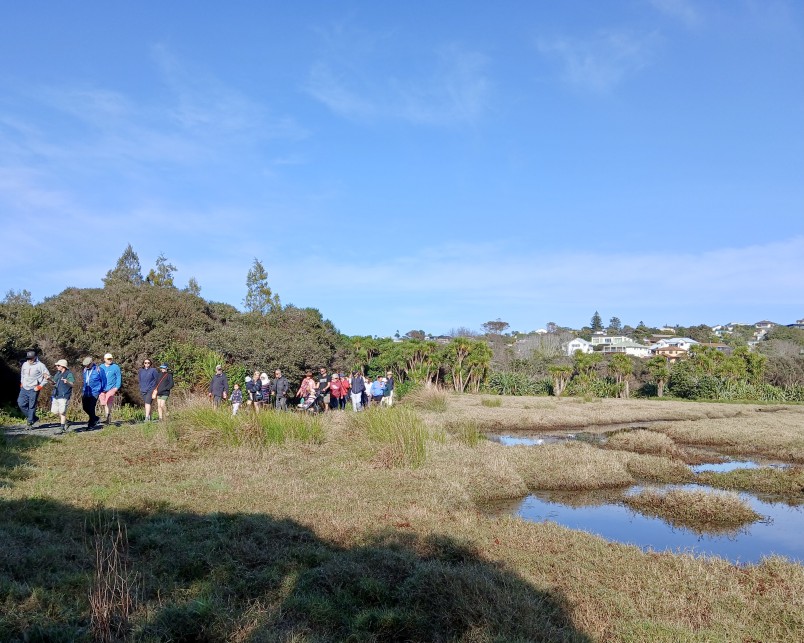
Forest & Bird-led community walk through wetlands in the project area. Credit Charlie Thomas
VIRTUAL PREDATOR FENCE
A new initiative, the Shakespear “Virtual Fence”, aims to create an intensive network of predator control throughout a residential area that borders important wetlands in Shakespear Regional Park.
These wetlands are home to pūweto spotless crake, moho pererū banded rail, and mātātā fernbird, and where many of the rarities introduced to the fenced sanctuary, such as pōpokotea whitehead, spread out.
We hope to reduce pressure on the wetlands from predators encroaching from surrounding areas and support the work being carried out by Auckland Council rangers and volunteers within the regional park.
The project made the cover of local paper Hibiscus Matters, and Charlie Thomas has been getting creative with engaging the local community, including working with local drone videographer Sam Kynman-Cole to bring to life what we are trying to achieve.
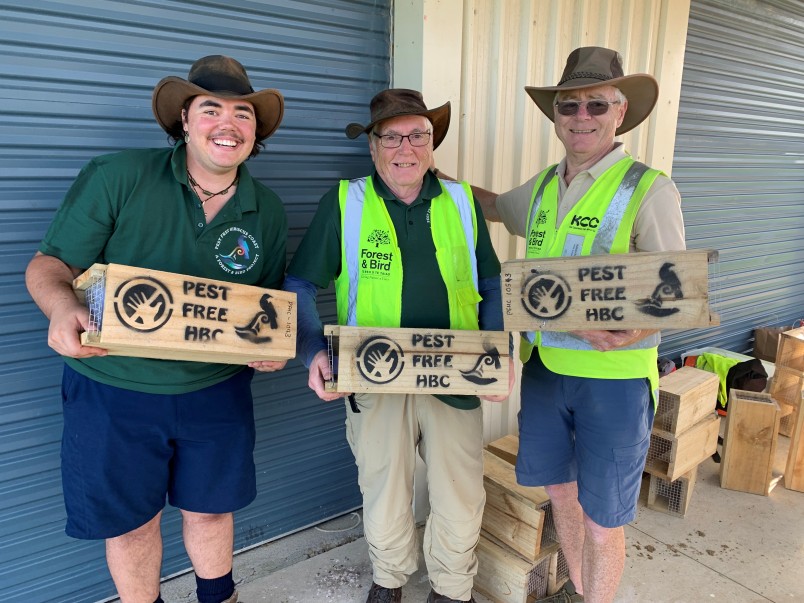
Charlie Thomas with volunteers Derek Kelsey and Julian Fripp. Credit Jenny Hanwell
